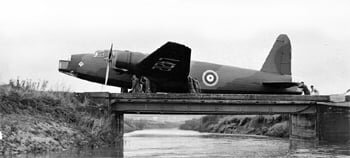The French industry also used similar tricks... "temporary" propellers and wheels for ferry flights... except the lack of coordination with subcontractors had the "temporary" coming to the frontline (!) I kid you not: MB-152s delivered to the frontline with fixed pitch wooden propellers, two blades... and then you wonder why France collapsed in 1940 ?
(my rant is over)
The methodology of French aircraft production in the run up to WW2 was well and truely screwed up. Build the airframe to flying condition. Then ferry it to a seperste facility for weapons or radio installations. That's the type of thing a politician dreams up to spread the work around. It's one thing to have the subcontractors spread out and ship components in.
In Britain aircraft generally went from factory to Maintenance Unit where various pieces of govt furnished equipment would be added. That often included armament, radios, gunsights, radar sets or other role specific equipment. It would even include repainting the aircraft if need be (for example Coastal Command Mosquitos in 1944/45) if the standardised factory scheme were not appropriate for the theatre/unit they were to be sent to.
Well, if that process is a perfectly well oiled machine, then there is no reason it can't work. And the British did a perfect job there. In stark comparison, French warplanes from the 1930's were fucked up (sorry for the swearing) - fucked up from the RFP and drawing board to combat: from craddle to grave, every single step along the way was perfectly screwed up.
And I'm not exagerating. In fact the system was so broken, dysfunctional, and unefficient, many pilots and mechanics ended thinking "Can't be true. It can only be sabotage".
And thus were born the myths of the 5th column
France 1939-40 before the German onslaught was kind of
"The broken thing is FUBAR or SNAFU. Can't be negligence, can only be sabotage.
And thus...
"Communist workers sabotaged the aircraft
"Free masons sabotaged the aircraft
"German spies sabotaged the aircraft
"Jews sabotaged the aircraft
"Peace activists sabotaged the aircraft
"[
enter convenient scapegoat here] sabotaged the aircraft
I kid you not: everybody was picking imaginary sabotages to try and rationalize what was, plain and simply, absolute stupidity or laissez faire.
Case in point: winter 1939 was horrible. Heavy bombardement squadrons were flying antiquated Amiot 143s (and in May they would still fly them in daylight to try and bomb that Sedan bridghead).
Those Amiot engines were rotten because the engine manufacturers were rotten, plants, bosses, managers included. And of course the cold made things worse.
So the engines were dismounted and send back to the engine plants for heavy maintenance.
When the engine came back they were still dysfunctional, if not more.
The mechanics were so baffled and pissed off, they could only think about "SABOTAGE". They just couldn't figure the engine shops were just rotten.
TBH, 1939 France was rotten to the core, at every level: from politics to the military leadership to the industry. It was a hopeless case.
The 1940 collapse was perhaps 20% of insane luck for the germans, 20% them being smart, and 60% of utter and absolute stupidity and inefficiency on the French side. Don't you ever starts me on Gamelin or Huntziger: they made Cadorna & Caporetto looks like Sun Tzu or Clausewitz brilliance.
(I'll stop there -
sorry for the thread hijacking).

